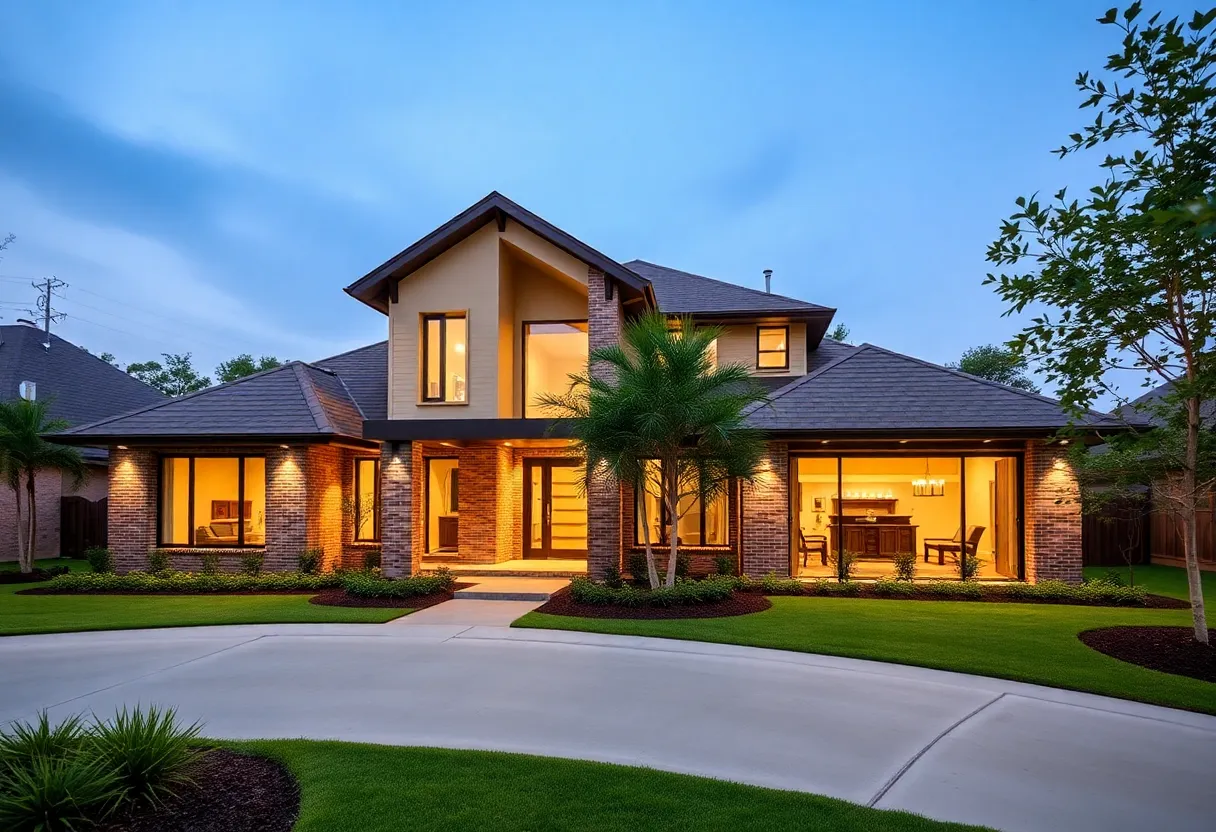What Are the Key Considerations for Custom Home Building in Houston?
Building a custom home in Houston presents a unique opportunity to craft a residence tailored specifically to your lifestyle and aesthetic preferences. However, the process demands careful planning and an understanding of Houston’s distinctive environmental and regulatory landscape. Addressing critical considerations from climate adaptation to legal requirements helps ensure the resulting home is durable, functional, and suited to its environment.
1. Climate Adaptation
Houston’s subtropical climate significantly influences design choices. Summers are hot and humid, and winters are generally mild, but weather can be unpredictable. Proper climate adaptation enhances comfort and minimizes energy costs.
- Energy-Efficient HVAC Systems: Select systems capable of managing high humidity and temperature fluctuations. In Houston, HVAC efficiency can greatly reduce energy bills and improve intra-home air quality.
- Proper Insulation: Use materials such as spray foam or dense pack fiberglass in walls and attics. Effective insulation maintains consistent indoor temperatures and manages humidity.
- Durable Roofing Materials: Opt for metal roofs or composite shingles designed to endure the extreme weather. These materials resist wind uplift, rain infiltration, and UV damage.
2. Flood Risk Management
Flooding poses a significant threat in Houston, necessitating proactive measures.
- Site Selection: Prioritize lots in low-risk flood zones. Consult FEMA flood maps and local zoning plans.
- Elevated Foundations: Consider raised or pier-and-beam foundations to prevent flood damage and facilitate water runoff.
- Effective Drainage Systems: Incorporate French drains, swales, and tiling to channel water away. Landscaping techniques can enhance runoff efficiency.
- Flood-Resistant Materials: Use concrete, stone, or pressure-treated wood for areas vulnerable to water intrusion. These materials reduce long-term damage risks.
3. Material Selection
Material choices impact both aesthetic appeal and resilience.
- Exterior Elements: Use weather-resistant sidings like fiber cement or brick. Durable paving materials prevent cracking and erosion over time.
- Interior Finishes: select low-maintenance, moisture-resistant finishes in high-humidity areas like kitchens and bathrooms to prevent mold and deterioration.
4. Compliance with Local Regulations
Houston’s building codes and zoning laws are designed for safety and community integrity.
- Permits and Approvals: Secure all necessary permits before commencing construction. This includes building, electrical, plumbing, and environmental permits.
- Homeowners Association Guidelines: If your lot is within an HOA Community, review regulations regarding property aesthetics and zoning.
- Windstorm Compliance: Incorporate wind-resistant design features such as hurricane clips and reinforced windows, complying with regional mandates for areas prone to hurricanes.
5. Lot Selection
Your property’s characteristics directly influence design and construction.
- Accessibility: Choose a lot with easy access to transportation, schools, and amenities. Consider future development plans that might affect your property.
- Orientation: Position your home to maximize natural light and shade, reducing cooling costs in Houston’s climate.
- Soil Conditions: Houston’s clay-heavy soil may require specialized foundation work, including soil stabilization or pilings, to ensure structural stability.
6. Lifestyle Considerations
Tailor your home design to accommodate your family’s routines and preferences.
- Open Floor Plans: Facilitate interaction and flexibility, ideal for modern lifestyles.
- Multi-Functional Spaces: Design areas like home offices, fitness centers, or hobby rooms to adapt to evolving needs.
- Aging in Place Features: Incorporate wider doorways, step-free entries, and accessible bathrooms to enhance mobility and future-proof the home.
7. Integration of Smart Home Technology
Enhancing convenience and efficiency through automation is increasingly popular.
- Smart Security Systems: Use remote surveillance, automated locks, and motion detectors to secure your residence.
- Voice-Controlled Devices: Implement smart lighting, thermostats, and entertainment controls for a seamless experience.
- Energy Monitoring Systems: Track energy consumption real-time to optimize usage and reduce costs.
8. Builder Selection
Choosing an experienced and reputable builder is vital.
- Experience: Select builders familiar with Houston’s climate, regional materials, and legal landscape.
- Communication: Look for transparency, consistent updates, and responsiveness throughout the project.
- Quality Craftsmanship: Opt for contractors known for their attention to detail and use of high-grade materials to ensure longevity.
9. Budget Planning
A well-structured budget prevents financial surprises.
- Land Acquisition: Account for lot costs, factoring in location premium and site-specific preparation.
- Construction Costs: Include building materials, labor, permits, and design fees.
- Contingency Fund: Reserve approximately 10-15% for unforeseen expenses such as soil issues or material price fluctuations.
10. Construction Timeline
Realistic scheduling ensures timely project completion.
- Design and Permitting: Allocate sufficient time for architectural plans, engineering assessments, and permit approvals.
- Construction Phases: Breakdown into foundation, framing, systems installation, and finishing stages, with buffers for delays.
- Move-In Readiness: Coordinate inspections and final walkthroughs to ensure home is ready on schedule.
11. Environmental Sustainability
Eco-conscious building practices are essential amidst growing environmental concerns.
- Energy-Efficient Appliances: Choose ENERGY STAR-rated appliances that save resources and lower utility bills.
- Sustainable Materials: Source responsibly harvested or recycled building supplies with low environmental impact.
- Water Conservation: Incorporate low-flow fixtures, rainwater harvesting, and drought-tolerant landscaping.
12. Resale Value
Designing with future marketability in mind increases long-term investment potential.
- Market Trends: Stay current on popular features and finishes, aligning your design with buyer preferences.
- Quality Construction: Use premium materials that withstand wear and maintain appeal.
- Curb Appeal: Focus on landscaping, exterior finishes, and entryway design to make a positive first impression.
13. Legal Considerations
Navigate legalities proactively to avoid future disputes.
- Title and Ownership: Verify clear property titles before construction begins.
- Contractual Agreements: Draft detailed contracts outlining scope, deadlines, and payment schedules.
- Insurance: Obtain builder’s risk, liability, and flood insurance to mitigate construction-related risks.
14. Community Integration
Ensure your home complements and interacts positively within its neighborhood.
- Architectural Harmony: Design that respects local styles and community guidelines.
- Community Engagement: Participate in neighborhood events or initiatives to establish good relationships.
- Local Services: Ensure proximity to hospitals, schools, shopping, and public transport enhances convenience.
15. Post-Construction Support
Ongoing maintenance preserves home value and comfort.
- Warranty: Secure comprehensive coverage for structural and system defects.
- Maintenance Plan: Establish routine inspections, HVAC servicing, and landscaping schedules.
- Customer Service: Select builders offering responsive support and clarity beyond project completion.
16. Personalization
Make the residence reflect your unique taste.
- Interior Design: Choose colors, textures, and furnishings that resonate with your personality.
- Outdoor Spaces: Create patios, gardens, or outdoor kitchens to extend living outside.
- Unique Features: Incorporate custom cabinetry, artwork, or architectural accents for individuality.
17. Technological Infrastructure
Prepare your home for future tech needs.
- Pre-Wiring: Install conduits and outlets for electric vehicle chargers, solar inverters, or future automation.
- Data Management: Ensure robust internet infrastructure with ample wiring and outlets for high-speed connectivity.
- Adaptability: Design flexible spaces to accommodate technological upgrades without major renovations.
18. Noise Control
Minimize disturbances with strategic soundproofing.
- Soundproofing Materials: Use acoustic insulation, double-pane windows, and resilient flooring.
- Landscaping: Strategically plant trees and shrubs to buffer external noise.
- Window Treatments: Incorporate soundproof window inserts or thick curtains for added noise insulation.
19. Accessibility
Design a home suitable for all ages and abilities.
- Universal Design: Focus on features that serve individuals with disabilities or mobility challenges.
- Entrances and Hallways: Ensure wide, step-free access points for wheelchair compatibility.
- Bathroom Features: Include grab bars, roll-in showers, and accessible sinks to promote safety and convenience.
20. Security Measures
Protect your home with layered security.
- Surveillance Cameras: Install around perimeter and critical interior points.
- Alarm and Monitoring Systems: Use systems that can be remotely accessed and professionally monitored.
- Exterior Lighting: Use motion-activated floodlights and pathway lighting to deter intruders.
21. Landscaping
Enhance both aesthetics and functionality outdoors.
- Native Plants: Choose drought-tolerant species for sustainability and low maintenance.
- Outdoor Living Areas: Design decks, patios, or outdoor kitchens to extend your usable space.
- Irrigation Systems: Install efficient watering solutions to conserve water and maintain healthy greenery.
22. Lighting Design
Maximize both natural illumination and artificial lighting.
- Natural Light: Incorporate skylights, larger windows, and glass doors for daylight maximization.
- Artificial Lighting: Use layered lighting—ambient, task, and accent—to enhance functionality and ambiance.
- Energy Efficiency: Select LED fixtures and dimmers to minimize power consumption.
23. Storage Solutions
Optimize space with smart storage options.
- Closets and Cabinets: Incorporate organizational features like shelving, drawers, and built-in organizers.
- Basement and Attics: Utilize these spaces for additional, discreet storage.
- Multi-Purpose Furniture: Use furniture with built-in storage to maximize utility.
24. Maintenance Considerations
Design for ease of upkeep and long-term sustainability.
- Materials: Choose durable, weather-resistant finishes that require minimal maintenance.
- Design: Simplify cleaning with accessible surfaces and easy-to-reach fixtures.
- Landscaping: Favor low-maintenance plants and automated irrigation to reduce yard work.
25. Future Expansion
Build flexibility into your planning.
- Additional Rooms: Design structural frameworks that support adding bedrooms or living spaces later.
- Infrastructure: Install sufficient wiring and plumbing capacity for future upgrades or modifications.
- Zoning Laws: Ensure local ordinances permit further development if expansion is anticipated.
26. Community Amenities
Leverage local infrastructure for enhanced living.
- Parks and Recreation: Proximity to green spaces can improve lifestyle quality.
- Shopping and Dining: Close access to commercial hubs adds to convenience.
- Public Services: Easy access to healthcare, education, and transportation improves daily life.
27. Environmental Impact
Implement sustainable building practices.
- Sustainable Practices: Use eco-friendly construction methods and recycled materials.
- Renewable Energy: Invest in solar panels or wind turbines to reduce reliance on fossil fuels.
- Waste Management: Plan for recycling and waste reduction during construction and occupancy.
28. Insurance Requirements
Cover all potential risks effectively.
- Construction Insurance: Protect against accidents, damages, or delays during building.
- Homeowners Insurance: Secure coverage for fire, theft, and other common risks post-construction.
- Flood Insurance: Obtain additional coverage if building on flood-prone land, aligning with Houston’s risk profile.
29. Tax Implications
Be aware of how building impacts financials.
- Property Taxes: Understand how increased home value affects tax obligations.
- Tax Incentives: Explore available credits for energy efficiency, solar systems, or sustainable materials.
- Depreciation and Deductions: Consult with a tax professional on potential benefits related to home improvements.
Frequently Asked Questions
How does Houston’s climate influence home design?
What are the best flood mitigation strategies in Houston?
How important is compliance with local regulations?
What should I consider when selecting a builder in Houston?
How can I incorporate sustainability into my home?
Key Features of Custom Home Building in Houston
| Aspect | Key Consideration | Impact |
|---|---|---|
| Climate Adaptation | HVAC, insulation, roofing materials | Enhances comfort, reduces energy costs |
| Flood Management | Site selection, elevation, drainage, materials | Protects property, minimizes damage |
| Material Choice | Exterior and interior durability | Longevity, low maintenance |
| Regulatory Compliance | Permits, codes, HOA rules | Legal safety, smooth workflow |
| Builder Selection | Experience, transparency, quality | Project integrity, quality finish |
| Sustainability | Green materials, energy systems | Reduced environmental impact |
Author: STAFF HERE HOUSTON TX WRITER
The HOUSTON STAFF WRITER represents the experienced team at HEREHouston.com, your go-to source for actionable local news and information in Houston, Harris County, and beyond. Specializing in "news you can use," we cover essential topics like product reviews for personal and business needs, local business directories, politics, real estate trends, neighborhood insights, and state news affecting the area—with deep expertise drawn from years of dedicated reporting and strong community input, including local press releases and business updates. We deliver top reporting on high-value events such as Houston Livestock Show and Rodeo, Art Car Parade, and Chevron Houston Marathon. Our coverage extends to key organizations like the Greater Houston Partnership and Houston Area Urban League, plus leading businesses in energy and healthcare that power the local economy such as ExxonMobil, Schlumberger, and Houston Methodist. As part of the broader HERE network, including HEREAustinTX.com, HERECollegeStation.com, HEREDallas.com, and HERESanAntonio.com, we provide comprehensive, credible insights into Texas's dynamic landscape.





